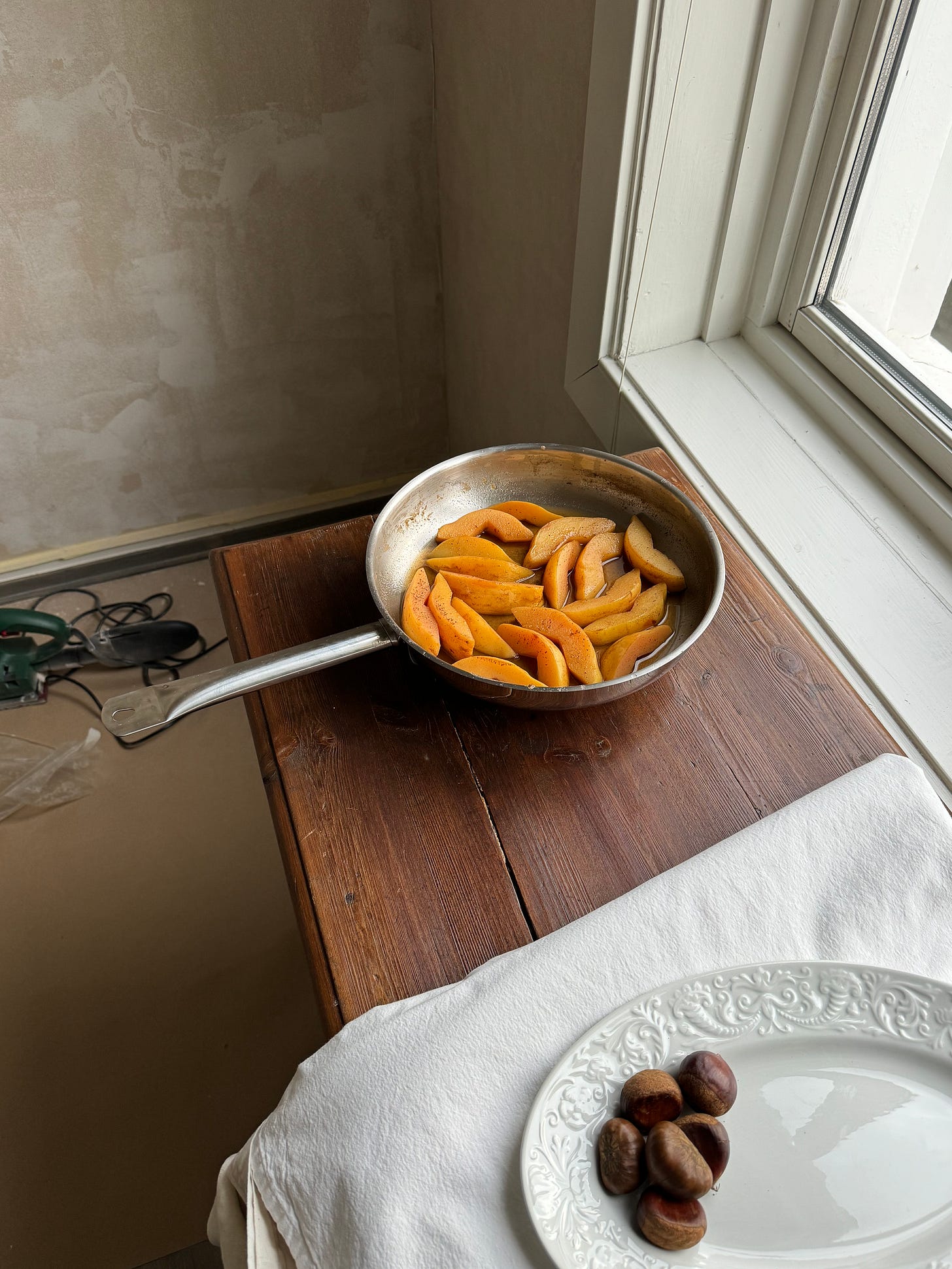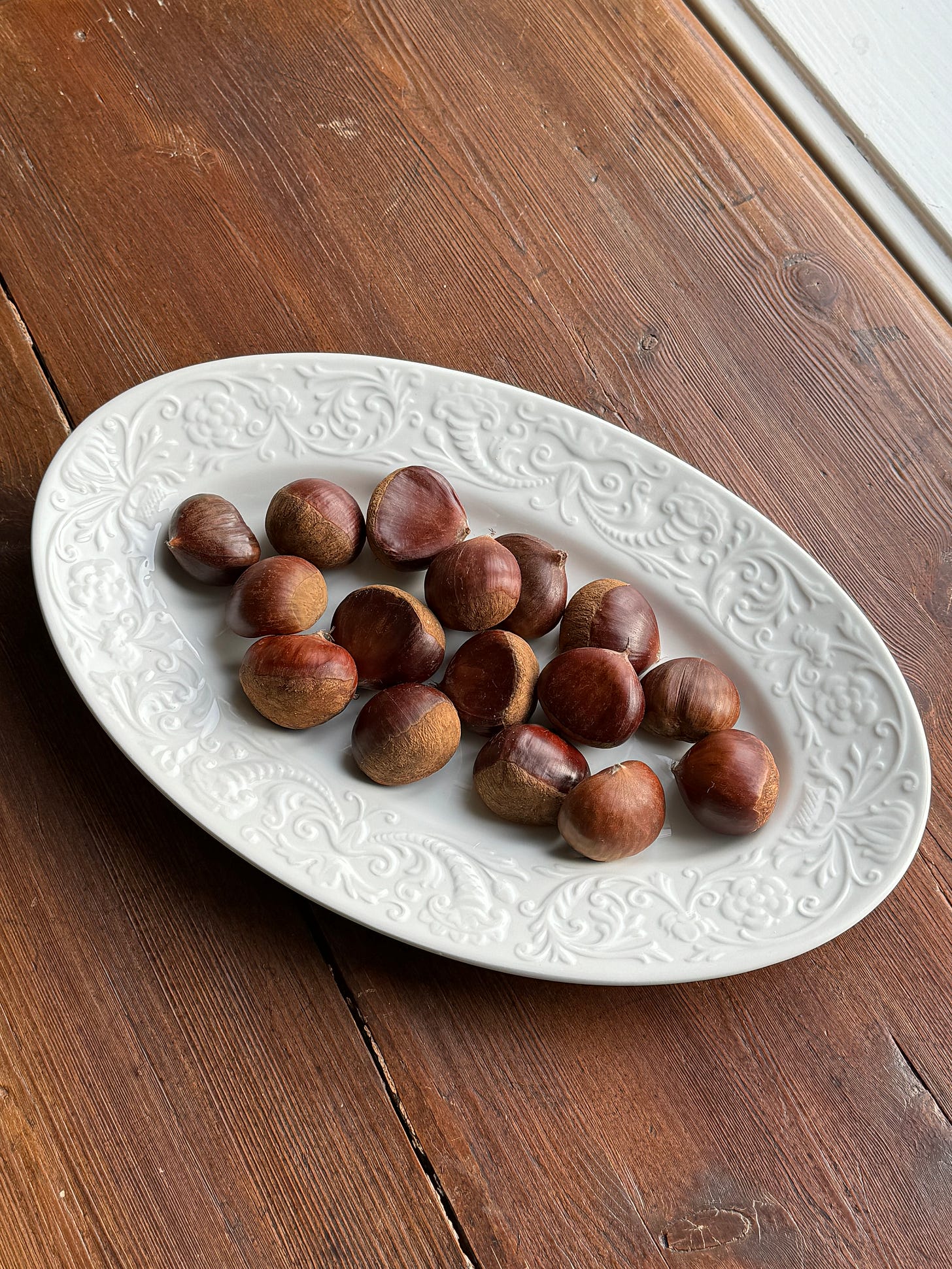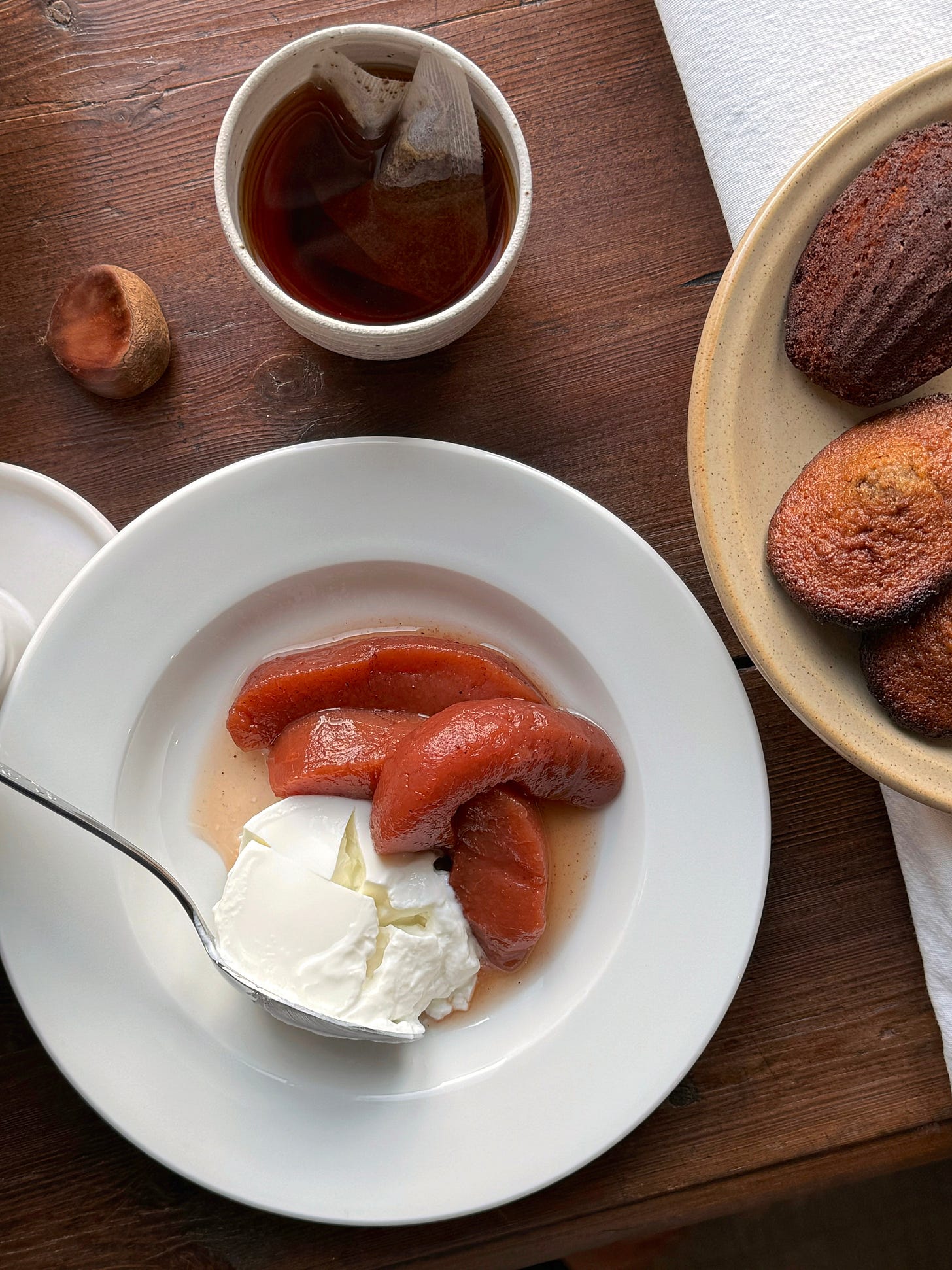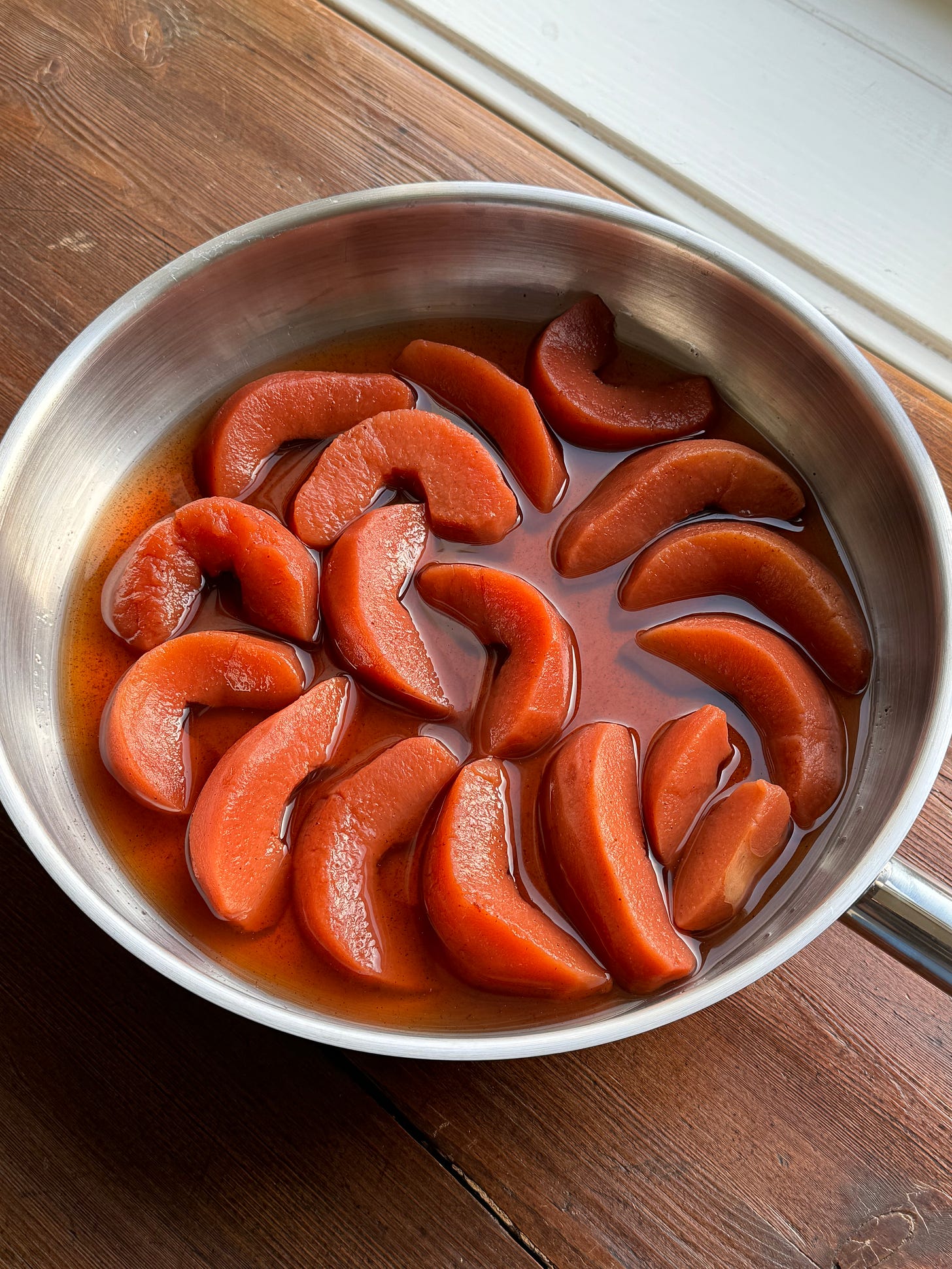👋+: Honey-Poached Quinces & Chestnut Madeleines
sweet soothers + slow simmers (plus, putting culinary plastic & non-stick in the hot seat)
Allô! 👋
Welcome (back) to seasonal sundays, the fortnightly supplement to good food at home, where we take a closer peek at produce at its peak — with a short introduction, at least one recipe, and a (sometimes related) cooking Q&A. If you’re a new subscriber and would like to read the previous issues, you can click here to find them!
Happy Sunday!
I hope you’re all doing well and finding ways to enjoy November, in spite of recent and ongoing world events.
On today’s menu, to help take your mind off of it all, we’ve got an introduction to quinces, honey, and chestnuts, plus two recipes: one for honey-poached quinces (+ a bonus cheat’s quince jelly) and one for subtly-chocolatey chestnut madeleines. To finish, we end with a Q&A on what to do about plastic and non-stick in the kitchen.
Otherwise, an announcement: following the publication of this issue, payments will be put on hold for seasonal sundays subscribers. I know, I’m sad about it too. As mentioned in the last newsletter, I’ve just moved! The place I’m in now is a bit of a fixer-upper and doesn’t exactly have a proper working kitchen, so the paid newsletter issues will have to be moved to the back burner until the kitchen is “fixer-uppered” and can be properly used again. If all goes to plan, seasonal sundays will be back up and running again in early 2025. Meanwhile, the free good food at home newsletters will continue, with their usual tentative publication date on the last day of every month.
As always, hope you enjoy today’s read and recipes!
Wishing you all warming, restoring, and comforting days ahead.
— Simone
P.S. If you enjoy this post, please do kindly give it a ❤️ — it really helps make it more visible so others can find it too!
While summer was all about doing anything and everything to avoid having to turn on an oven or stand in front of a hot stove, the transition into late autumn is all about keeping the oven running, the stovetop humming, and the fireplace crackling. What better way then to embrace the cold and dark than to make soothing, remedying, and pacifying meals all while keeping your home a toasty, warmly lit refuge from the doom and gloom outside.
For me, November is synonymous with slowly simmering the season’s last freshly picked quinces, roasting the year’s first chestnuts, and sweetening anything that needs a mellowing touch with a healthy drizzle of this year’s honey.
Below, some tips for making the most of these three:
HOW TO SHOP FOR, STORE, AND USE: QUINCES
Although quinces are in season during the autumn months, typically from September through to November in the Northern Hemisphere, their availability can also extend into early winter, depending on the region and climate. Native to regions around the Caucasus, Iran, and Central Asia, quinces thrive in temperate climates and are cultivated in many parts of the world — from the Mediterranean to the Americas and Oceania, they can even be grown as far north as the UK and Norway.
shopping
This definitely depends on where you live, but, in my experience, if you’re looking to buy quinces, big supermarkets and large grocery chains are most likely to let you down. Instead, turn to your local greengrocer (the Turkish ones tend to be a treasure trove), farmers’ markets, or that friendly neighbour with the unmistakeable tree (they’re bound to have more quinces than they know what to do with). Choose fruit that feel heavy for their size. A coating of fluff is more than fine — in fact, it suggests freshness — and a russet patch here or there is okay too, but you’ll want to steer clear of fruit with bruises or soft spots. (Note that unripe quinces will be green, turning progressively yellow as they ripen from within. The ripest ones will be unmistakeable: golden, firm, and with an irresistible aroma reminiscent of honeyed roses — a sweet floral scent that hints at the delicious potential beneath their tough, fuzzy skin.)
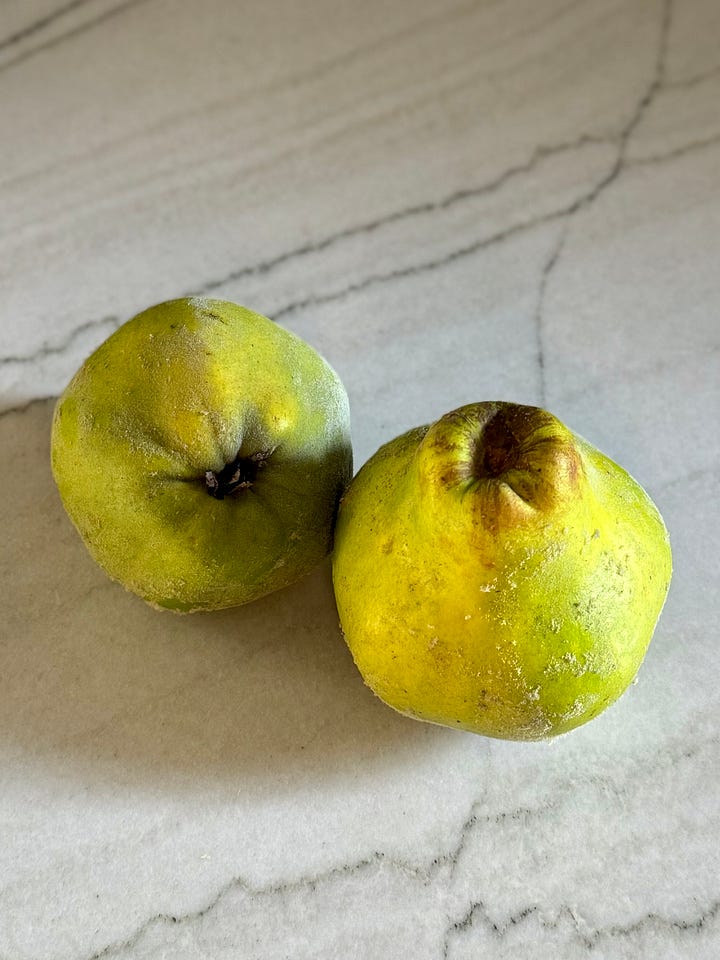

storage
Back home, give any quinces you plan on using soon pride of place in a spot where you’ll be able to admire them with all of your senses: think of them as natural air fresheners! They can stay at room temperature, out of direct sunlight, for up to a week. Placed in a sealed bag or container, however, they can keep in the fridge for up to a month. For quinces that you’d like to store for even longer, keep them in a cool, dark place (like a garage, cellar, or dedicated pantry/unheated cupboard) between 0–4°C/32–40°F, placed in a box or tray in a single layer (with gaps between each fruit), away from other produce. Stored this way, and checked on regularly, unblemished barely-ripe quince can typically keep for 3 months.
uses
Once golden and ripe, let their heady perfume draw you in. While quinces look somewhat like pears, you should most definitely not bite into one raw. Though certain varieties can be enjoyed left uncooked, simply prepared by thinly slicing and rubbing with fresh citrus, most quinces will be a lot more pleasant to eat once cooked. When ready to use, coax them into submission with slow, patient cooking. Quinces can be grated and added to apple and pear desserts where their fellow fruit will be roasted, or simply, as is more common, slowly poached or roasted until their firm pale flesh yields to reveal a tender sweet flavour within. Slow candying turns them into amber jewels, and many love to push the limit and cook their quince for hours on end, until they eventually reveal a deep ruby blush. Whether stirred into yogurt or crowning a buttery sponge, ready to elevate a simple tart or spooned over a creamy panna cotta, they never fail to deliver a moment of indulgence.
HOW TO SHOP FOR, STORE, AND USE: HONEYS
Honey, oh sweet honey! Though it is available to enjoy year-round, it’s good to know that most honey varieties are harvested between late spring and late summer — with some harvests occurring as late as early fall — depending on the local microclimate and the flowers in bloom. This means that any honey you enjoy today will, in essence, be a sweet capsule of sunshine and fresh blossoms from sunnier days gone. What a delight!
shopping
When shopping for honey, look for raw, unfiltered varieties if you want the full spectrum of flavour and potential health benefits. Labels like “local” and “single-origin” can be clues to unique and distinct flavour profiles, reflecting the flora of a particular region (and there’s always a special pleasure in tasting the honey made from the nature that had, earlier in the year, been blooming right around you!).
While supermarket honey is convenient, it’s often blended and pasteurised, which can dull its flavour and mute its character. Instead, farmers’ markets, specialty stores, or direct purchases from beekeepers often yield higher-quality options, and in a much more diverse array. Endless varieties of honey exist, each influenced by the blossoms the bees visit, though the most common ones on the market include clover honey, which is mild and sweet, wildflower honey (a more robust and varied variety), acacia honey, which is delicate and floral, and buckwheat honey: a dark, rich, and almost molasses-like variety. Honey can be runny, sometimes straight from the hive and still unprocessed on the comb, or instead creamed or whipped — crystallised for a smooth and luscious, spreadable texture. The best way to discover what you like is to try as many as you can.
storage
You’ll want to store your honey in a cool, dark place, in a tightly sealed container. Avoid the fridge — it speeds up crystallisation, though crystallised honey is perfectly fine to eat (just warm it gently to restore its smooth texture) — and don’t worry too much about expiration dates. Honey’s low moisture content, high sugar levels, and natural antibacterial properties mean it won’t spoil if kept properly.
uses
Honey’s versatility makes it an essential in any kitchen. Drizzle it over creamy yogurt, spread it on warm buttery toast, or swirl it into fragrant tea. Add a touch of sweetness to salad dressings or use it in marinades, where it works its caramelising magic. In baking, honey brings moisture and a delicate aroma — perfect for complementing quince’s natural sweetness or keeping madeleines delectably tender. For a simple yet luxurious treat, pair honey with cheese, fresh fruit, nuts, and crackers. Experiment with combinations: wildflower honey with tangy goat’s cheese, or dark buckwheat honey alongside ripe figs and walnuts. A spoonful stirred into warm milk, of course, remains the ultimate comfort: a balm for body and soul.
HOW TO SHOP FOR, STORE, AND USE: CHESTNUTS
Chestnuts season is well and truly here. Often easy to spot in city parks across temperate climates, chestnuts are usually harvested in autumn, typically from late September through November, as they fall naturally from the trees when fully ripe. They’re at their best and most widely available during the cooler months, making them a quintessential fall and winter ingredient, with varieties like the European sweet chestnut and the Asian chestnut most common, while the American chestnut, once abundant, has become a rare treat due to widespread blight.
shopping
When selecting chestnuts, aim to choose ones that feel heavy for their size, with glossy, firm shells free of cracks, holes, or mould. Avoid chestnuts that rattle when shaken, as this can indicate they’ve dried out — freshness is key, as chestnuts are perishable compared to other nuts, and should be nice and creamy as opposed to crunchy when you give them a bite. Another way to check this before buying a chestnut is to give is a squeeze: it should feel hard, with no give. If you feel space between the shell and the nut inside, it’s likely old, shrivelled, and past its prime. Good to know: a visit to a farmers’ market or specialty store will often provide fresher, higher-quality options than a standard supermarket.
storage
Fresh chestnuts, once home, should be stored in the refrigerator in a breathable container — think paper bags — to help retain their moisture. Stored this way, they’ll stay fresh for up to two weeks. If you’d like to keep them longer, you can peel them, either raw or cooked, then freeze them for later. Dried chestnuts and chestnut flour, on the other hand, can simply be tucked into an airtight container and kept in a cool, dark place.
uses
Chestnuts have a slightly sweet, nutty flavour and a soft, creamy texture when cooked. Subtle, but oh so comforting. One of the most popular ways to enjoy chestnuts is to roast them, especially over fire (if you haven’t experienced this firsthand at a winter market, you may have at least heard a song about it). At home, roasting in the oven is a simple and satisfactory substitute. They can also be boiled, steamed, or pureed for soups, stuffings, or desserts like Mont Blanc (though, a word to the wise: always score their shells before cooking to prevent any dramatic bursts as steam will build up inside the hard outer shell). Their versatility shines in savoury dishes like pasta, risotto, or paired with Brussels sprouts and bacon, butternut squash and sage. Meanwhile, their sweet potential is equally delightful: chestnut flour, made from dried nuts, is a star in gluten-free baking or, for example, traditional treats like the rustic Tuscan cake, castagnaccio.
BONUS TIP: SORTING THE GOOD FROM THE BAD
One extra thing to know about chestnuts is that they won’t always be fresh or good to eat. As alluded to above, sometimes chestnuts get old and dried out, sometimes a critter crawls into them, sometimes they get mouldy. Please don’t let any of this put you off — instead, learn to recognise what makes a chestnut good to eat. A simple water test can help sort the treasures from the disappointments. Once home, submerge your shiny, unblemished, heavy-for-their-size chestnuts in water. Any that float are likely inedible. The ones that sink? They’re your golden ticket — perfect for roasting, simmering, or transforming into something delicious.
There’s something about the sun setting before 4pm (and most of the light being gone shortly after 2pm) that just makes me want to slow down in the kitchen (it also sometimes makes me want to crawl into a comfortable cave and hibernate until March, but that’s another matter).
Be it by gently poaching honey-scented wedges of quince for hours on end, or in taking the time to blanch, roast, peel, toast, then grind chestnuts into my own chestnut “flour”, somehow these seasonal comforts seem to make the passing of ever-shortening days and lengthening nights feel quite alright — if not an absolute delight.
Below is my go-to recipe for poached quinces, plus a method for making my (might I say) delightfully addictive, subtly chocolatey, chestnut madeleines. If you don’t already have a metal madeleine mould at home, you can use a mini muffin tin, or even just muffin moulds placed on a baking sheet. (They won’t quite have the same shape, but it’s the texture and flavour that count!) If cake is more up your alley, you may want to give this glorious quince and chestnut cake a try instead.
[Note: as always, today’s recipes are available to download in a printable PDF down below.]
honey-poached quince ✨
This recipe requires relatively little active effort on your part — all you have to do is slice and core some quinces, then pop them into a quick-poaching liquid — but, for the most dazzling results, committing to this recipe will require a bit of patient foresight: the quinces are most flavoursome and colourful after a long poach, plus a night spent chilling in their poaching liquid. If you’re short on time, however, you can also achieve delicious (albeit less pink) wedges of heavenly-perfumed fruit and poaching liquor in as little as an hour and a half.
Wonderful with yogurt or porridge for breakfast, with cake, ice cream or plain mascarpone for dessert, or simply as a sweet, standalone treat. All you really need is a spoon — and someplace quiet to swoon.
HONEY-POACHED QUINCE
makes approx. 16 wedges, or roughly 5 servings (breakfast for every day of the work week!)
INGREDIENTS
Keep reading with a 7-day free trial
Subscribe to good food at home to keep reading this post and get 7 days of free access to the full post archives.






